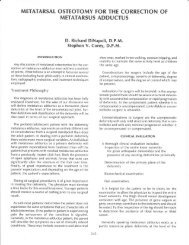anatomic approach to preparation and fusion of the interphalangeal ...
anatomic approach to preparation and fusion of the interphalangeal ...
anatomic approach to preparation and fusion of the interphalangeal ...
Create successful ePaper yourself
Turn your PDF publications into a flip-book with our unique Google optimized e-Paper software.
54CHAPTER 12Figure 7A. Deviation <strong>of</strong> resection angle in <strong>the</strong>transverse plane can occur on one side as depicted, or<strong>to</strong> varying degrees on both resection surfaces.Figure 7B. Apposition <strong>of</strong> <strong>the</strong> joint after this type <strong>of</strong>resection will need revision <strong>to</strong> achieve uniform jointapposition.Figure 8A. Deviation <strong>of</strong> resection angle in <strong>the</strong> sagittal plane can occur onone side as depicted, or <strong>to</strong> varying degrees on both resection surfaces.Figure 8B.Apposition <strong>of</strong> <strong>the</strong> joint after this type <strong>of</strong> resection will needrevision <strong>to</strong> achieve uniform joint apposition.<strong>to</strong> high <strong>and</strong> low areas <strong>of</strong> bone ends that may not beadequately apposed when <strong>the</strong> joint is fixated (Figures 9-15).In addition <strong>to</strong> <strong>the</strong> technical problems with <strong>the</strong>ir use,<strong>the</strong>re are certain deficiencies with <strong>the</strong>se set-ups. Care mustbe taken with high speed powered saws <strong>to</strong> minimizeprolonged contact with <strong>the</strong> bone ends <strong>and</strong> avoid excessiveheat generation. This is a function <strong>of</strong> <strong>the</strong> relatively largesurface area <strong>of</strong> <strong>the</strong> side <strong>of</strong> <strong>the</strong> blade rapidly moving against<strong>the</strong> bone surface <strong>and</strong> generating friction. It is widely knownthat excessive heat generation can result in bone cell death,<strong>and</strong> consequently can compromise <strong>the</strong> intended outcome <strong>of</strong><strong>the</strong> operation. Saw blade depth can also be problematic in<strong>the</strong> sense that <strong>the</strong> oscillations carry <strong>the</strong> square cutting surfacethrough an arc, <strong>and</strong> consequently <strong>the</strong> blade edges escapein<strong>to</strong> <strong>the</strong> s<strong>of</strong>t tissues when cutting <strong>the</strong> small cylindrical bone.H<strong>and</strong> instrumentation is not without its owndeficiencies; <strong>the</strong> method can be extremely slow due <strong>to</strong>multiple passes back <strong>and</strong> forth between <strong>the</strong> surgical site <strong>and</strong>a sponge <strong>to</strong> remove <strong>the</strong> material from <strong>the</strong> instrument. InFigure 9. Complete removal <strong>of</strong> joint surfaces usingmicrosaws leaves uniformly flat surfaces. These c<strong>and</strong>rift, in ei<strong>the</strong>r <strong>the</strong> transverse or sagittal planes, orrotate in <strong>the</strong> frontal plane.
















